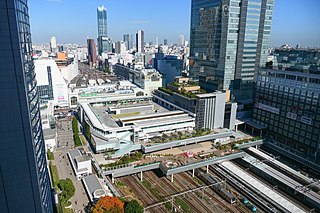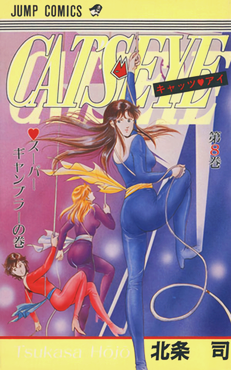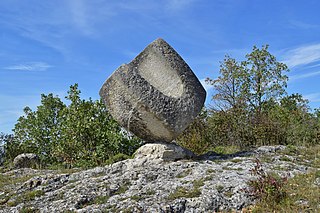
Shinjuku, officially called Shinjuku City, is a special ward of Tokyo, Japan. It is a major commercial and administrative center, housing the northern half of the busiest railway station in the world as well as the Tokyo Metropolitan Government Building, the administrative center of the Tokyo Metropolitan Government. As of 2018, the ward has an estimated population of 346,235 and a population density of 18,232 people per km2. The total area is 18.23 km2. Since the end of World War II, Shinjuku has become a major secondary center of Tokyo (fukutoshin), rivaling the original city center in Marunouchi.

Shibuya is a special ward in the Tokyo Metropolis, Japan. A major commercial center, Shibuya houses two of the busiest railway stations in the world, Shibuya Station and Shinjuku Station. As of January 1, 2024, Shibuya Ward has an estimated population of 230,609 in 142,443 households and a population density of 15,262.01 people per square kilometre. The total area is 15.11 km2 (5.83 sq mi). Notable neighborhoods and districts of Shibuya include Harajuku, Ebisu, Omotesandō, Yoyogi and Sendagaya. "Shibuya" is also commonly used to refer to the area surrounding Shibuya Station, an area known as a major center for Japanese fashion and youth culture, and one of Tokyo's most popular nightlife areas.

Toshima is a special ward in the Tokyo Metropolis in Japan. It is one of the eight central wards of the Tokyo Metropolitan area. Located in the northern area of Tokyo, Toshima is bordered by the wards of Nerima, Itabashi, and Kita in the north and Nakano, Shinjuku, and Bunkyo in the south.

Shinjuku Station is a major railway station in Tokyo, Japan, that serves as the main connecting hub for rail traffic between central/eastern Tokyo and Western Tokyo on the inter-city rail, commuter rail, and subway lines. The station straddles the boundary between the Shinjuku and Shibuya special wards. In Shinjuku, it is in the Nishi-Shinjuku and Shinjuku districts; in Shibuya, it is in the Yoyogi and Sendagaya districts.

Kabukichō is an entertainment district in Shinjuku, Tokyo, Japan. Kabukichō is considered a red-light district with a high concentration of host and hostess clubs, love hotels, shops, restaurants, and nightclubs, and is often called the "Sleepless Town". Shinjuku Golden Gai, famous for its plethora of small bars, is part of Kabukichō.

Cat's Eye is a Japanese manga series written and illustrated by Tsukasa Hojo. It was serialized in Shueisha's shōnen manga magazine Weekly Shōnen Jump from 1981 to 1985, with its chapters collected into 18 tankōbon. The story follows the adventures of the three Kisugi sisters — Hitomi, Rui and Ai, who are formidable art thieves trying to collect all the works belonging to their missing father.

Tochōmae Station is a subway station on the Toei Ōedo Line in Shinjuku, Tokyo, Japan, operated by the Tokyo subway operator Toei Subway.

Minoru Niizuma was a Japanese abstract sculptor.

Shinjuku-sanchome Station is a subway station in Shinjuku, Tokyo, Japan, operated jointly by the two Tokyo subway operators, Tokyo Metro and Toei Subway.

Higashi-shinjuku Station is a subway station in Shinjuku, Tokyo, Japan, operated by the two Tokyo subway operators Tokyo Metropolitan Bureau of Transportation (Toei) and Tokyo Metro.

The Shinjuku Mitsui Building is a high-rise building in Nishi-Shinjuku, Shinjuku, Tokyo. It is owned by Mitsui Fudosan. It is one of the ten tallest buildings in Tokyo, and was the tallest building in Tokyo and Japan from September 1974 to March 1978, when Sunshine 60 was completed.

The Japan Transport Safety Board is Japan's authority for establishing transportation safety. It is a division of the Ministry of Land, Infrastructure, Transport and Tourism (MLIT).

Rica Takashima is a prolific pop artist and manga artist who has had exhibitions and shows in museums and galleries in New York City and as well as across Japan.

The Shinjuku I-Land Tower (新宿アイランドタワー) is an office skyscraper located in Shinjuku, Tokyo, Japan. Construction of the 620.08 feet (189.00 m), 44-storey skyscraper construction began in 1990 and was finished in 1995.
Mikiko Hara is a Japanese photographer.
Makoto Azuma is a Japanese flower artist, botanical sculptor, and co-founder of JARDINS des FLEURS.

The Godzilla head is a landmark and tourist attraction in Kabukichō, Shinjuku, Tokyo, Japan. The sculpture is accessible from the Hotel Gracery Shinjuku's Godzilla Terrace, on the Shinjuku Toho Building. It depicts Godzilla, occasionally with "glowing eyes and smoky breath". The 80-ton head, based on Godzilla's appearance in Godzilla vs. Mothra (1992), was unveiled in 2015. Its placement on the Hotel Gracery terrace matches Godzilla's 50 meter height seen during the Showa era films in the franchise.

The Ni-Tele Really Big Clock is a large clock and sculpture designed by Hayao Miyazaki, installed outside the second story of the Nittele Tower in Minato Ward, Tokyo, Japan. The structure, which is made entirely of hand-worked copper and steel plates, is 12 meters tall by 18 meters long and contains 32 separate moving mechanical features. This clockwork assembly performs a three-minute show a few times each day.

Growing Gardener is a sculpture by Inges Idee, installed in Tokyo, Japan.
Tokyo Brushstroke I and II, or Tokyo Brushstrokes, refers to two 1994 aluminum sculptures by Roy Lichtenstein. Copies are installed outside Shinjuku I-Land Co, Ltd., in Tokyo, Japan, and at the Parrish Art Museum in Watermill, New York.
















